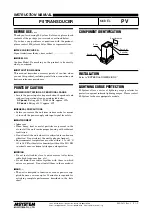
A
Q
G
-1
012
0
-0
1
xylem.com
©2022 Sensus. All products purchased and services performed are subject to Sensus’ terms of sale, available at either sensus.com/TC or 1-800-638-3748. Sensus reserves the right to modify these
terms and conditions in its own discretion without notice to the customer. The Sensus logo is a registered trademark of Sensus.
This document is for informational purposes only, and SENSUS MAKES NO EXPRESS WARRANTIES IN THIS DOCUMENT. FURTHERMORE, THERE ARE NO IMPLIED WARRANTIES, INCLUDING
WITHOUT LIMITATION, WARRANTIES AS TO FITNESS FOR A PARTICULAR PURPOSE AND MERCHANTABILITY. ANY USE OF THE PRODUCTS THAT IS NOT SPECIFICALLY PERMITTED HEREIN IS
PROHIBITED.
SENSUS
| 637 Davis Drive | Morrisville, NC 27560 | 800.638.3748 | sensus.com
Attention!
Under Industry Canada regulations, this radio transmitter may only operate using
an antenna of a type and maximum (or lesser) gain approved for the transmitter by
Industry Canada. To reduce potential radio interference to other users, the anten-
na type and its gain should be so chosen that the equivalent isotropically radiated
power (e.i.r.p.) is not more than that necessary for successful
communication.
Conformément à la réglementation d’Industrie Canada, le présent émetteur
radio peut fonctionner avec une antenne d’un type et d’un gain maximal (ou
inférieur) approuvé pour l’émetteur par Industrie Canada. Dans le but de réduire
les risques de brouillage radioélectrique à l’intention des autres utilisateurs, il faut
choisir le type d’antenne et son gain de sorte que la puissance isotrope rayonnée
équivalente (p.i.r.e.) ne dépasse pas l’intensité nécessaire à l’établissement d’une
communication satisfaisante.
Warning!
ANTENNAS: An outdoor antenna system should not be located in the vicinity of
overhead power lines or other electric light or power circuits, or where it can come
in contact with such power lines or circuits as death or serious injury can occur. Be
sure the antenna ysstem is grounded so as to provide some protection against
voltage surges and built-up static charges. Section 810 of the National Electric
Code (NEC) in the U.S.A. provides information with respect to proper grounding
of the mast and supporting structure, grounding of the lead-in wire to an antenna
discharge unit, size of grounding conductors, location of antenna discharge unit,
connection to grounding electordes and requirements for the grounding electrode.
Antenna grounding shall be according to the National Electrical Code, ANSI/NFPA
70.
Warning!
This product can expose you to chemicals including Di(2-ethylhexyl)phthalate
(DEHP), which are known to the State of California to cause cancer or birth defects
or other reproductive harm. For more information, visit www.P65Warnings.ca.gov.





















